The Complete Stun Gun Guide
Stun guns are among the most effective non-lethal self-defense tools available today. These handheld devices deliver a high-voltage, low-amperage electrical shock that temporarily incapacitates attackers by disrupting muscle control and causing disorientation, providing critical seconds to escape dangerous situations. Unlike firearms, stun guns are legal in most areas, require no permits in most states, and cause no permanent injury.
Whether you’re seeking personal protection while walking alone, a non-lethal defense option for your home, a safety tool for college students, or simply want peace of mind in uncertain situations, this comprehensive guide covers everything you need to know about stun guns—from how they work and legal considerations to choosing the right model for your specific needs.
What Are Stun Guns and How Do They Work?
A stun gun is a handheld electrical self-defense device that delivers a high-voltage shock through direct contact with an attacker. When activated against a target, the electrical charge disrupts voluntary muscle control, causing temporary immobilization and allowing you to escape.
The Science Behind Stun Guns
Electrical Output: Stun guns generate high voltage (typically 1-10 million volts) but low amperage (3-4 milliamps). The high voltage overcomes the body’s resistance and penetrates clothing, while the low amperage prevents lethal injury or permanent damage.
How They Affect the Body:
- Immediate effect (1 second contact): Painful shock, muscle contractions, psychological deterrent
- Short burst (1-2 seconds): Intense pain, muscle spasms, moderate confusion
- Full incapacitation (3-5 seconds): Loss of balance and muscle control, disorientation, temporary incapacitation (effects last 5-15 minutes)
Safety Profile: Stun guns cause no permanent damage. Effects are temporary, and the attacker will fully recover within minutes with no lasting harm. They don’t affect the heart or cause cardiac issues in healthy individuals. The electrical charge doesn’t transfer to you even if you’re touching the attacker.
Stun Guns vs. Tasers: Important Difference
Stun Guns (Contact Weapons):
- Require direct physical contact with attacker
- Work at zero distance only
- No projectiles—press device against attacker
- Legal in more areas
- Much less expensive ($20-100 typically)
- No licensing required in most states
Tasers (Distance Weapons):
- Fire projectile electrodes up to 15+ feet
- Work at distance
- Launch barbed probes that attach to clothing/skin
- More legal restrictions (often restricted to law enforcement)
- Very expensive ($400-1,500+)
- May require licensing
This guide focuses on stun guns (contact weapons), which are more accessible, affordable, and practical for civilian self-defense.
Why Stun Guns Are Effective
Physical Incapacitation: Unlike pepper spray that requires the attacker to flee or personal alarms that depend on others responding, stun guns physically immobilize attackers through disruption of neuromuscular control.
Works in Any Weather: Rain, wind, indoor spaces—none affect stun gun effectiveness. No environmental factors reduce performance.
No Collateral Damage: Only affects the person touched. Won’t contaminate rooms like pepper spray or affect bystanders.
Psychological Deterrent: The visible electrical arc and crackling sound often deter attackers before physical contact is necessary.
Reusable: No cartridges or refills needed. Use repeatedly without ongoing costs.
Stun Gun Laws and Legal Considerations
Stun gun laws vary significantly by state and locality. Understanding legal restrictions is essential before purchasing.
Federal Law (United States)
No federal law prohibits civilian ownership of stun guns. However, federal law prohibits: carrying stun guns on airplanes (checked or carry-on), mailing stun guns through USPS (can ship via private carriers like FedEx/UPS), and felons possessing stun guns in most jurisdictions.
State Laws: Where Stun Guns Are Restricted
States Where Stun Guns Are Illegal for Civilians:
- Rhode Island: Stun guns illegal for civilian possession
- Hawaii: Illegal except with permit (difficult to obtain)
States With Significant Restrictions:
- Michigan: Permit required to purchase or possess
- Illinois: Requires FOID (Firearm Owner’s Identification) card
- Wisconsin: Cannot be concealed
- Connecticut: Permit required, restrictions on voltage
- New York: Legal with restrictions; some counties/cities prohibit
- New Jersey: Legal with permit for specific purposes
- Massachusetts: FID card required
States Where Generally Legal: Most other states allow stun gun ownership without permits or restrictions, though local ordinances may apply.
Local Laws and Ordinances
Even in states where legal, some cities and counties prohibit or restrict stun guns. Major cities with restrictions include certain areas of New York City, some California cities, Chicago (despite state law), Baltimore and Annapolis (Maryland), and Philadelphia areas. Always check local laws in your specific city and county before purchasing.
Age Restrictions
Most states that allow stun guns require buyers to be 18 or older. Some states require 21+. Minors generally cannot legally possess or carry stun guns even with parental permission.
Where You Cannot Carry Stun Guns
Even where legal to own, stun guns are prohibited in:
- Schools, school grounds, school buses (K-12, often includes colleges)
- Government buildings (courthouses, city halls, federal buildings)
- Airports and airplanes (TSA prohibited items)
- Some private businesses (signs posted, honor restrictions)
- Bars and establishments serving alcohol (some states)
- Public events and venues (stadiums, concerts—check policies)
Legal Use of Stun Guns
Self-Defense: Stun guns may only be used in legitimate self-defense situations where you reasonably believe you’re in imminent danger of bodily harm. You cannot use a stun gun for: offensive purposes, settling arguments, intimidation or threats, on someone who poses no threat, or in retaliation after danger has passed.
Legal Standard: Use of a stun gun must be proportional to the threat. Generally justified when facing physical attack, attempted assault or battery, robbery or mugging, home invasion, or credible threat of immediate harm.
Consequences of Illegal Use
Illegal possession or use can result in: criminal charges (misdemeanor or felony depending on circumstances), fines ($500-$10,000+), jail or prison time, civil liability (victim can sue for damages), and confiscation of device. Some states classify illegal stun gun use as assault with a deadly weapon.
Best Practices for Legal Compliance
- Verify state and local laws where you live, work, and travel
- Keep documentation proving legal purchase and ownership
- Never carry where prohibited even if you forget it’s there
- Only use for legitimate self-defense when in actual danger
- Understand use-of-force laws in your jurisdiction
- Training recommended to know when and how to use legally
Critical: This guide provides general information, not legal advice. Stun gun laws change frequently and vary by jurisdiction. Always verify current laws in your specific location before purchasing or carrying a stun gun. When in doubt, consult with a local attorney familiar with weapons laws.
Types of Stun Guns
Stun guns come in various designs for different needs and preferences.
Standard Handheld Stun Guns
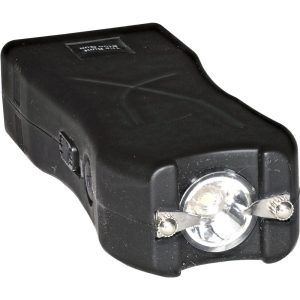
Traditional rectangular or curved grip design—the most common type.
- Design: Ergonomic grip, electrodes on top, typically 5-8 inches long
- Voltage: 1-10 million volts typical
- Features: Safety switch, LED flashlight, rechargeable battery, wrist strap
- Best for: Home defense, vehicle storage, general purpose self-defense
- Advantages: Affordable ($20-50), easy to use, good grip, effective
- Considerations: Larger size, less concealable than compact models
Compact/Mini Stun Guns
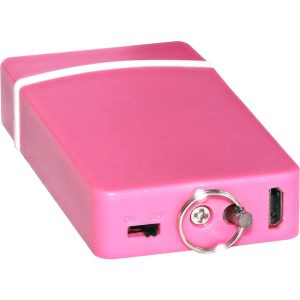
Small, pocket-sized models for maximum concealability.
- Design: 3-5 inches, lightweight, fits in pocket or small purse
- Voltage: 3-8 million volts
- Best for: Everyday carry, jogging, concealed carry, travel
- Advantages: Highly portable, very concealable, lightweight
- Considerations: Smaller grip may be less comfortable, shorter reach
- Price: $20-60
Flashlight Stun Guns
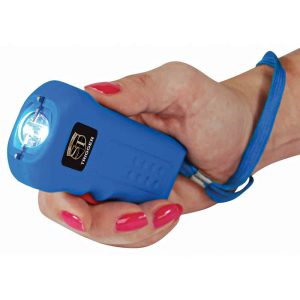
Dual-purpose devices combining tactical flashlight with stun capability.
- Design: Looks like large flashlight, electrodes at striking end
- Features: Bright LED (100-200 lumens), stun capability, often aluminum body
- Best for: Walking at night, home defense, vehicle emergency tool
- Advantages: Multi-purpose (light + defense), tactical appearance, good reach, sturdy construction
- Considerations: Larger size, heavier than standard models
- Price: $30-80
Disguised Stun Guns

Concealed in everyday objects for maximum element of surprise.
Lipstick Stun Guns: Look like oversized lipstick tubes. Extremely small and concealable. Perfect for purses. $25-50.
Cell Phone Stun Guns: Resemble smartphones. Highly disguised. Easy to carry openly. $30-60.
Keychain Stun Guns: Attach to keys. Always accessible. Very compact. $20-40.
Advantages: Complete concealment, element of surprise, natural to carry openly.
Considerations: Smaller power than full-size models, may be harder to grip, sometimes less intuitive to activate.
Baton Stun Guns
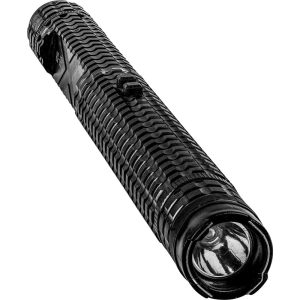
Extended reach models, often used by security professionals.
- Design: 12-18 inches long, expandable or fixed length
- Features: Extended reach, strike capability, professional appearance
- Best for: Security personnel, home defense, situations requiring distance
- Advantages: Maximum reach, can be used as impact weapon, intimidating presence
- Considerations: Not concealable, may have additional legal restrictions, expensive ($50-150)
Stun Guns With Alarm
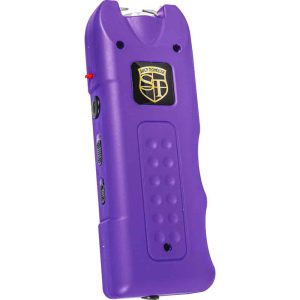
Dual-function devices combining high-decibel personal alarms with electrical stopping power for multi-level defense.
- Design: 4-7 inches, integrated 110-130 decibel alarm, visible electrodes, alarm activates independently of stun function
- Voltage: 2-10 million volts
- Alarm Output: 110-130 decibels (audible from blocks away)
- Best for: Urban environments, college students, evening commuters, joggers, situations where drawing attention beneficial
- Advantages: Two defense tools in one device, alarm deters 85-90% of attacks without physical contact, draws help from bystanders, escalation options (start with alarm, use stun if needed), more cost-effective than buying separate devices, legal alarm function works everywhere
- Considerations: Both functions drain battery (requires regular charging), alarm may alert attacker you’re armed, combined device may have slightly lower specs than dedicated high-end models, stun gun component still subject to state restrictions
- Common Types: Compact keychain models with alarm, flashlight-alarm-stun gun combinations (tri-function), baton-style with extended reach and alarm
- Price: $25-80
Knuckle Stun Guns
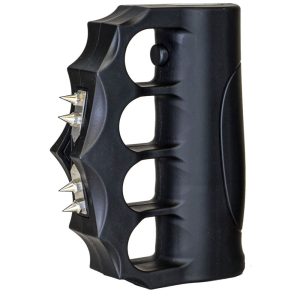
Worn over knuckles like brass knuckles with stun capability.
- Design: Fits over fist, electrodes on striking surface
- Best for: Close-quarters defense, those comfortable with hand-to-hand
- Considerations: Classified as knuckles in some jurisdictions (illegal), requires very close contact, niche use
- Price: $30-70
Choosing by Use Case
Everyday Carry (Purse/Pocket): Compact or disguised models (lipstick, mini stun guns)
Jogging/Walking: Compact with wrist strap or flashlight models
Home Defense: Standard handheld or flashlight stun guns (more power, better grip)
Vehicle Storage: Flashlight stun guns (dual purpose, always accessible)
Maximum Concealment: Disguised models (lipstick, cell phone, keychain)
Professional Use: Baton stun guns (security, law enforcement)
Choosing the Right Stun Gun
Key Features to Consider
1. Voltage:
- 1-3 million volts: Basic protection, adequate for most situations
- 3-5 million volts: Standard, good balance of power and reliability
- 5-10 million volts: Maximum stopping power, recommended for serious protection
- Higher voltage = better penetration through thick clothing and more reliable incapacitation
2. Size and Concealability:
- Compact (3-5″): Maximum concealment, everyday carry
- Standard (5-8″): Good balance, better grip
- Large/Baton (12-18″): Maximum reach, not concealable
- Consider where you’ll carry: purse, pocket, vehicle, home
3. Safety Features:
- Safety switch (prevents accidental activation)
- Disable pin (renders device useless if taken from you)
- Wrist strap with disable function
- Triple safety systems (best option)
4. Power Source:
- Rechargeable (built-in battery, USB charging): No battery costs, always ready if charged regularly, most convenient
- Replaceable batteries (9V, AA, CR123): Longer shelf life, can carry spares, better for infrequent use
- Recommendation: Rechargeable for everyday carry, replaceable for emergency vehicle storage
5. Additional Features:
- LED flashlight (100-200 lumens ideal)
- Alarm function (loud siren to draw attention)
- Rubberized grip (better control)
- Carrying case or holster
- Lifetime warranty (indicates manufacturer confidence)
Budget Guide
$20-40: Basic models, adequate voltage (1-3 million), standard features, good for first-time buyers.
$40-70: Quality models, higher voltage (5-8 million), better features (rechargeable, LED, safety systems), best value range.
$70-150: Premium models, maximum voltage (8-10 million), professional quality, baton or specialized designs.
Recommendation: $40-70 range provides best balance of power, features, and value for most users.
Matching Stun Gun to Your Situation
Urban Dweller (Walking/Public Transit): Compact or disguised model, easy to access in purse or pocket, rechargeable for convenience. Budget: $30-50.
Suburban Homeowner: Standard handheld or flashlight model, keep near bed or entry points, higher voltage for maximum protection. Budget: $40-80.
College Student: Compact model for campus carry (verify campus allows), concealable, rechargeable, LED light for dark paths. Budget: $25-45.
Jogger/Runner: Compact with wrist strap, lightweight, easily accessible while running, weather-resistant if possible. Budget: $30-50.
Security Professional: Baton or professional-grade model, maximum reach and power, durable construction, holster included. Budget: $60-150.
Senior Citizen: Easy-to-grip standard model, simple operation, built-in flashlight, safety switch to prevent accidents. Budget: $35-60.
How to Use a Stun Gun Effectively
Proper Usage Technique
- Grip firmly: Hold stun gun securely with dominant hand
- Remove safety: Switch off safety (practice this motion)
- Activate: Press trigger/button to create electrical arc
- Make contact: Press electrodes firmly against attacker (aim for large muscle groups)
- Hold 3-5 seconds: Maintain contact for full incapacitation
- Escape immediately: Once attacker is incapacitated, run to safety and call 911
Best Target Areas
Most effective (large muscle groups):
- Upper shoulder/neck area
- Torso/ribs
- Upper thigh/hip
- Stomach/abdomen
Less effective: Hands, feet, head (smaller muscle groups, harder to maintain contact)
Training and Practice
Familiarization (Do This):
- Practice drawing from carry location (purse, pocket, holster)
- Practice removing safety quickly
- Test activate in safe direction (creates arc but don’t touch anything)
- Time yourself: draw, safety off, activate (goal: under 2 seconds)
- Practice with non-dominant hand
Never: Test on yourself, another person, or animals. Never activate near flammable materials.
Maintenance
- Test monthly (brief activation to ensure it sparks)
- Recharge rechargeable models monthly (even if not used)
- Check battery levels regularly
- Keep clean and dry
- Store in accessible location
- Replace every 3-5 years or after heavy use
When to Use Your Stun Gun
Appropriate situations: Physical attack in progress, attempted assault, robbery or mugging, home invasion, credible immediate threat of harm, cannot escape safely without defending yourself.
Inappropriate use: Verbal argument only, no physical threat, after danger has passed, on someone restrained or not threatening you, intimidation or showing off.
Remember: Stun guns are last-resort self-defense tools. Your first priority is always to avoid confrontation and escape if possible.
Stun Guns vs. Other Self-Defense Tools
Stun Guns vs. Pepper Spray:
Stun Guns: Physical incapacitation, works in any weather, no contamination, requires contact, reusable indefinitely, $20-100.
Pepper Spray: Works at distance (6-20 feet), affected by wind, contaminates area, spray can be emptied, expiration date, $10-30 + refills.
Best approach: Many carry both—pepper spray for distance, stun gun for close contact if spray fails.
Stun Guns vs. Personal Alarms:
Stun Guns: Physically stop attacker, require contact, work anywhere.
Personal Alarms: Draw attention, require others nearby, no physical stopping power, legal everywhere (no restrictions).
Best approach: Personal alarm first (deterrent), stun gun if attack continues.
Stun Guns vs. Firearms:
Stun Guns: Non-lethal, fewer legal restrictions, less training needed, no permanent harm, cannot stop attackers at distance.
Firearms: Lethal force, extensive legal restrictions and permitting, significant training required, permanent consequences, effective at distance.
Best approach: Stun guns for non-lethal protection, firearms only if trained and legally permitted.
Frequently Asked Questions
Do stun guns really work?
Yes, stun guns are highly effective when used correctly. They deliver high-voltage electrical shock that disrupts neuromuscular control, causing temporary incapacitation. A 3-5 second contact results in loss of balance and muscle control, disorientation, and temporary immobility lasting 5-15 minutes—providing ample time to escape. Effectiveness depends on proper contact (must touch attacker), adequate voltage (5+ million volts recommended), and sufficient duration (3-5 seconds for full effect). Stun guns work through clothing, in any weather, and don’t require perfect aim like pepper spray. They cause no permanent damage—effects are temporary and the attacker fully recovers. Success rates are high when users maintain contact for full duration. However, they require close contact, won’t work at distance, and are less effective if attacker on drugs or extremely determined.
Are stun guns legal in my state?
Stun gun legality varies significantly by state. They are illegal for civilian possession in Rhode Island and Hawaii (permit required, difficult to obtain). States with significant restrictions include Michigan (permit required), Illinois (FOID card required), Wisconsin (cannot be concealed), Connecticut (permit required), New York (legal with restrictions, some areas prohibit), New Jersey (permit for specific purposes), and Massachusetts (FID card required). Most other states allow stun gun ownership without permits, though local city and county ordinances may apply. Additionally, stun guns are prohibited in schools, government buildings, airports, and other sensitive locations even where otherwise legal. Age restrictions apply—typically must be 18+ (sometimes 21+). Before purchasing, verify current laws in your state, county, and city, check workplace or school policies if you’ll carry there, and understand where you cannot legally carry even if ownership is permitted. Laws change frequently, so always verify current regulations.
Will a stun gun stop someone on drugs?
Stun guns are generally effective against people under the influence, but may require longer contact time. The electrical disruption affects muscles and nerves directly—it’s a physical disruption, not pain compliance. However, individuals on stimulants (meth, cocaine, PCP) or experiencing excited delirium may have reduced pain sensitivity and extreme determination, requiring the full 5-second contact rather than 3 seconds, and may continue moving despite disorientation. Alcohol and marijuana typically don’t significantly reduce stun gun effectiveness. For maximum effect against potentially intoxicated attackers: use highest voltage available (8-10 million volts), maintain full 5-second contact minimum, aim for large muscle groups (torso, thighs), and be prepared to escape immediately rather than expecting complete immobilization. While no self-defense tool works perfectly in all situations, stun guns remain effective because they physically disrupt muscle control rather than relying solely on pain or psychological deterrence. Always prioritize escape over subduing the attacker.
Can I bring a stun gun on an airplane?
No, stun guns are prohibited on airplanes by TSA regulations. You cannot carry them in carry-on luggage, checked luggage, or on your person when flying. This applies to all types including disguised stun guns, tasers, and any electrical self-defense devices. TSA will confiscate stun guns found during screening, you may face fines or criminal charges, and you could miss your flight due to additional screening. For travel, consider shipping your stun gun to destination via FedEx or UPS (not USPS), purchasing a new one at your destination if legal there, or using alternative self-defense tools legal for air travel (personal alarms, self-defense keychains without electrical components). When driving or taking ground transportation (train, bus), stun guns are generally permitted though you should verify carrier policies. Always check destination laws—your stun gun may be legal at home but illegal where you’re traveling.
How long does a stun gun charge last?
Rechargeable stun guns typically hold charge for 1-3 months of standby time when not used. With regular monthly testing and occasional use, you should recharge monthly to ensure readiness. A full charge usually takes 6-12 hours. Battery indicator lights show charge status. Best practices: charge monthly even if unused, test monthly (brief activation), recharge immediately after any actual use, don’t let battery fully deplete (damages long-term capacity), and replace stun gun every 3-5 years (battery capacity degrades). For replaceable battery models (9V, CR123, AA), batteries last 1-3 years in standby with occasional testing. These models have longer shelf life and you can carry spare batteries. For emergency vehicle storage or infrequent use situations, replaceable battery models are more reliable. For everyday carry where you can charge regularly, rechargeable models are more convenient and cost-effective.
What voltage stun gun should I get?
For effective self-defense, choose 5 million volts or higher. Here’s the breakdown: 1-3 million volts provides basic protection, adequate for most situations but may struggle with thick clothing. 3-5 million volts is standard power, good balance of effectiveness and affordability, works well for typical self-defense. 5-8 million volts offers strong protection, reliably penetrates clothing, recommended for serious personal defense. 8-10+ million volts is maximum stopping power, best penetration through heavy clothing, fastest incapacitation. Higher voltage doesn’t mean more dangerous (amperage stays low and safe), but it does mean better penetration through thick clothing, more reliable incapacitation, faster effect, and less contact time needed. For most users, 5-8 million volts provides excellent protection. If facing larger attackers, wearing location with heavy coats, or wanting maximum confidence in your device, choose 8-10 million volts. Don’t compromise on voltage to save $10-20—the difference in effectiveness is worth the small additional cost.
Can a stun gun be used against me?
If an attacker takes your stun gun, they could potentially use it against you. To prevent this: look for models with disable pin technology (device becomes useless if pulled from your body), wrist strap with disable function (renders device inoperable if strap pulled off), and holsters with retention systems. Practice techniques: maintain firm grip always, use wrist strap around your wrist, position your body so attacker cannot easily grab it, and escape immediately after use (don’t stay in range). If disarmed: create distance immediately, deploy backup defense tool (pepper spray, personal alarm), and run to safety. Good news: stun guns don’t transfer charge through contact—if you’re touching the attacker while using stun gun, you won’t be shocked. The electrical current flows between the two electrodes on the device, not through you. With proper grip and awareness, the risk of disarmament is low, especially if you use the device correctly (quick application, immediate escape).
How close do I need to be to use a stun gun?
Stun guns require direct physical contact—you must press the electrodes against the attacker’s body. Effective range is zero distance. This means you must be within arm’s reach, able to touch the attacker’s torso, shoulder, or thigh, and close enough to press device firmly against them. This close-contact requirement is both a limitation and an advantage. Limitation: Cannot defend from distance, must allow attacker into personal space, and puts you at risk if you miss or device fails. Advantage: Cannot miss if you make contact, works in confined spaces where pepper spray would contaminate everything, no projectiles to aim, and psychological deterrent (visible arc/sound) may stop attack before contact needed. For self-defense strategy: maintain distance if possible (try to escape first), if forced into close contact, deploy stun gun, consider carrying pepper spray as well (use from distance, stun gun if they close in), and practice drawing and activating quickly. The close contact requirement means stun guns work best as backup to other deterrents or when escape isn’t immediately possible.
Ready to Protect Yourself?
Stun guns provide powerful, non-lethal protection that physically incapacitates attackers, giving you precious time to escape dangerous situations.
For Personal Protection
Order stun guns for effective self-defense, non-lethal incapacitation, and peace of mind in uncertain situations.
For Retailers and Distributors
Browse our wholesale catalog for competitive bulk pricing on quality stun guns with high customer demand and excellent profit margins.
Questions About Our Wholesale Program?
Learn more about minimum orders, pricing tiers, dealer benefits, and how to get started.
Wholesale Program Information | Contact Us
Why Choose Safety Technology
Quality Products: We stock only reliable, tested stun guns from reputable manufacturers that deliver consistent stopping power.
Competitive Pricing: Whether ordering for personal use or buying in bulk, our pricing provides excellent value without compromising quality.
Expert Support: Our team understands self-defense products and can answer questions about features, legal considerations, and proper use.
Fast Shipping: Quick, reliable delivery gets protection to those who need it.
Customer Satisfaction: We stand behind the products we sell with responsive service and fair policies.
Explore Our Complete Self-Defense Line
Stun guns are one component of comprehensive personal protection. We also carry:
- Pepper Spray: Distance protection with immediate stopping power
- Personal Alarms: Audible deterrents and emergency devices
- Hidden Cameras: Covert surveillance and monitoring
- Diversion Safes: Hide valuables in plain sight
- Tactical Flashlights: Illumination and self-defense
- And More: Complete security and safety solutions
Disclaimer: Stun guns are self-defense tools that should only be used in legitimate situations where you reasonably believe you’re in imminent danger. This guide provides general information only and should not be considered legal advice. Stun gun laws vary significantly by state, county, and city, and change frequently. Users are solely responsible for understanding and complying with all applicable federal, state, and local laws regarding purchase, possession, carry, and use of stun guns. Illegal possession or use may result in criminal charges and civil liability. Always verify current laws in your jurisdiction before purchasing or carrying a stun gun. Improper use can result in injury. This guide does not replace proper training. When in doubt about legality or appropriate use, consult with local law enforcement or a qualified attorney. Stun guns are prohibited in some states and localities—verify legality before ordering.
This guide is regularly updated to reflect current information. Last updated: October 2025


